Dashi is the basic Japanese soup stock used in many Japanese dishes. Learn how to make Awase Dashi at home with umami-packed ingredients like kombu (dried kelp) and katsuobushi (dried bonito flakes).
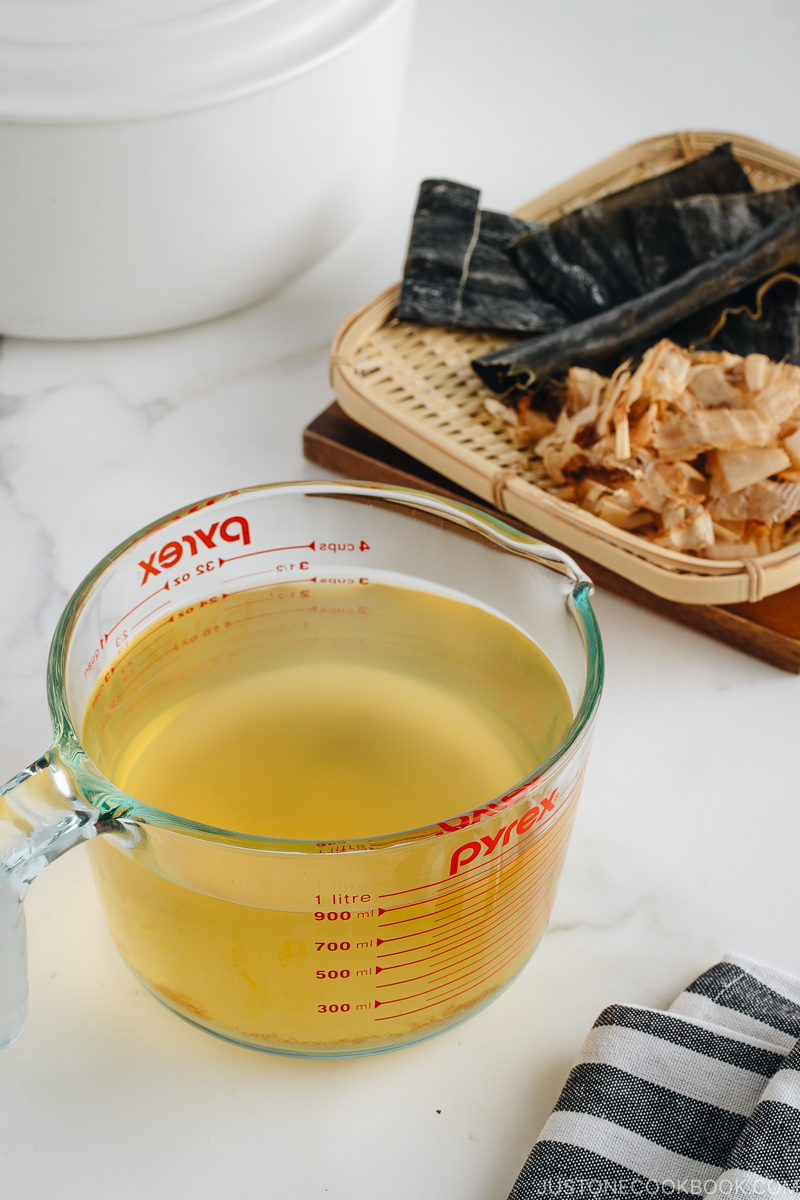
When you decide to make Japanese food, you will realize that a lot of recipes require dashi, Japanese soup stock.
With this unfamiliar ingredient, you may think Japanese food is hard to replicate at home. On the contrary, dashi is actually the easiest soup stock anyone can make from scratch as it requires only 1-2 ingredients and 20-minute prep time. This post shows you how you can make Awase Dashi using a combination of ingredients. Once you learn the ins and outs of dashi making, you’ll be ready to tackle Japanese cooking with a breeze.
Table of Contents
What is Dashi?
Dashi (だし, 出汁) is Japanese soup stock that builds the bases for many of your favorite Japanese dishes like miso soup, chawanmushi, ramen, and shabu shabu. It is the essence of authentic Japanese flavor, and it tells the dishes apart if other substitutions are being used in place of the soup stock. And what defines dashi is the use of carefully selected ingredients like kombu, bonito flakes, shiitake mushrooms, and anchovies, and each ingredient is uniquely Japanese.
In general, there are five different types of dashi (two are vegan). Scroll down to see 5 different types or check out my Ultimate Dashi Guide. When we say “dashi” in Japan, it usually implies Awase Dashi because it’s the most commonly used stock.
Awase Dashi (合わせだし) is made from a combination of kombu (dried kelp) and katsuobushi (dried bonito flakes), and it’s the seafood-based stock. *Awase (合わせ) means “to combine”, “mixed”, or “together.”
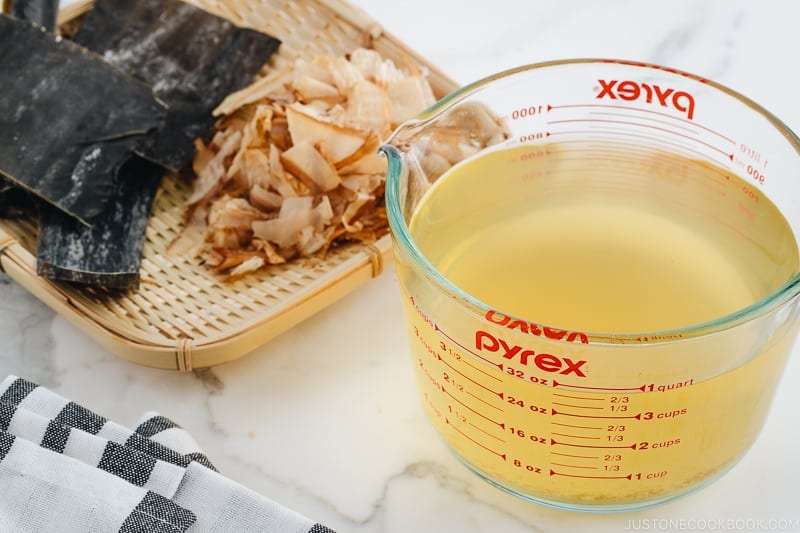
How to Make All-Purpose Basic Dashi
The First Dashi
The base of Awase Dashi is a vegan Kombu Dashi made from dried kelp. You can cold brew or hot brew kombu to make the dashi. Then you would add dried bonito flakes to the kombu dashi. This makes the stock more enriched. When you make dashi from the spent kombu and katsuobushi, it’s called Ichiban Dashi (一番だし). It’s basically the first pure dashi.
The Second Dashi
Niban Dashi (二番だし), or the second dashi is made from the spent kombu and katsuobushi, which you reserved from making Ichiban Dashi. Niban Dashi is a lighter, less intense dashi, yet still provides a great umami flavor despite the previously used ingredients.
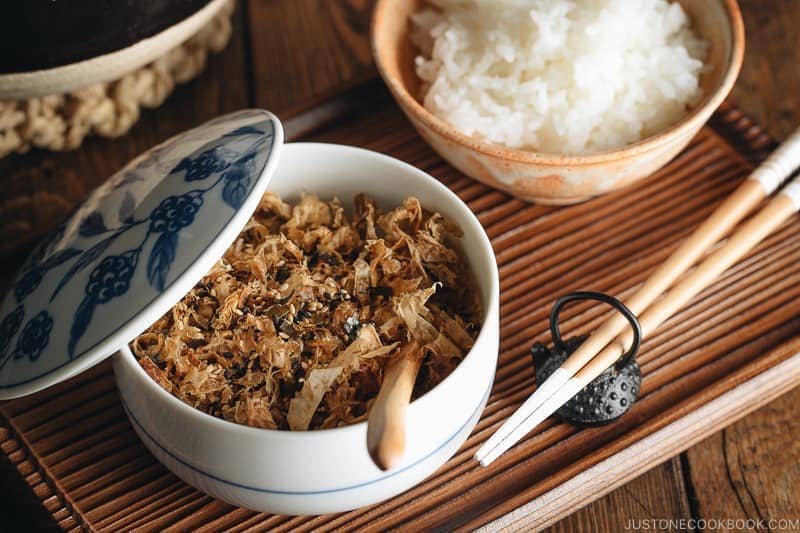
Do we really need to make dashi twice?
At a regular household, we make such a small amount of dashi that it’s not very efficient to make both Ichiban Dashi and Niban Dashi. My suggestion is to make very good Ichiban Dashi and utilize the used kombu and katsuobushi to make Homemade Furikake (rice seasoning) and Kombu Tsukudani (simmered kombu) after collecting enough used kombu and katsuobushi. This way, there will be no waste, and you get another side dish to accompany your meal.
So then who makes Niban Dashi? Japanese restaurants make a huge batch of dashi daily. They use Ichiban Dashi for dishes like Clear Soups (Osumashi おすまし) and Chawanmushi, which require the pure and maximum amount of umami from the dashi ingredients. They typically use Niban Dashi for simmered food (Nimono) and miso soup, which doesn’t require much flavor from the soup stock.
Dashi Shortcut
Sometimes life happens and you just don’t have 20 minutes to make dashi from scratch. On those occasions, you can use Dashi Packet or Dashi Powder.
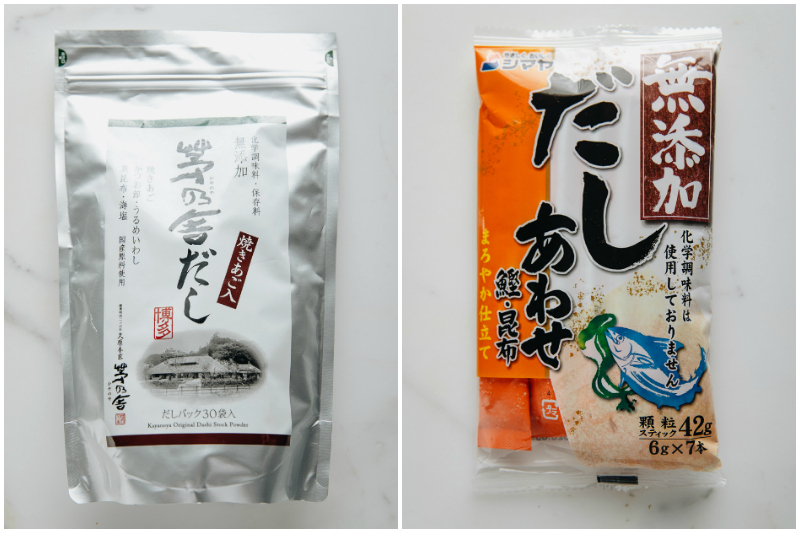
I love using Kayanoya Dashi Packet (left) and Shimaya Dashi Powder (right). Both are MSG-free and additive-free. You can purchase them at Japanese grocery stores or on Amazon:
The instruction on how to use them (recipes) can be found in the Dashi Packet post and Dashi Powder post.
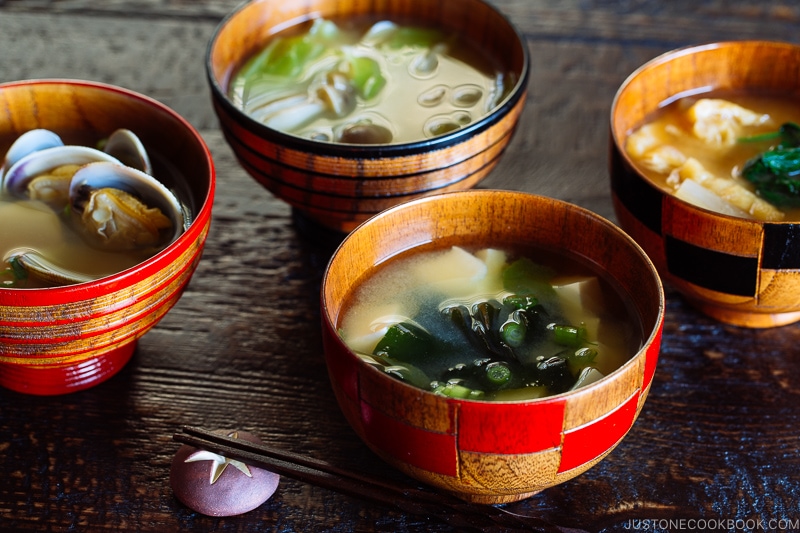
Easy & Delicious Recipes Using Dashi
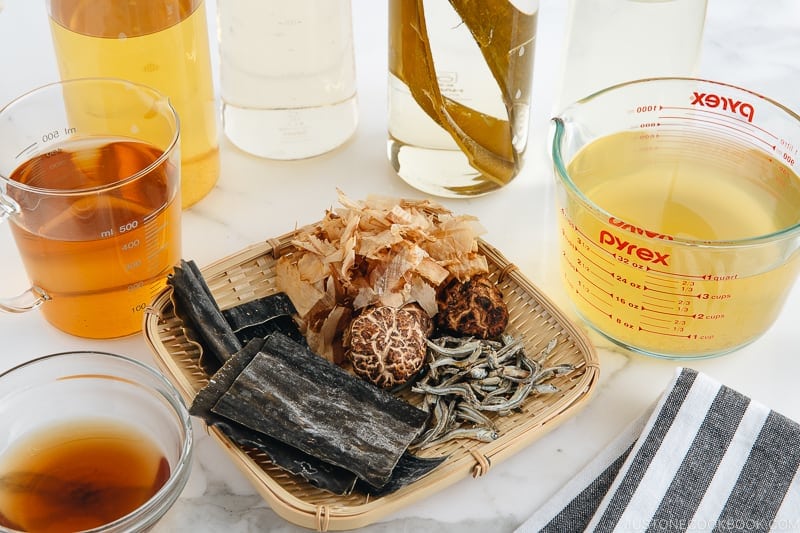
The Ultimate Dashi Guide
Dashi plays an important role as a flavor enhancer in Japanese cooking, so you don’t need to season the food with too much salt, fat, and sugar. Rich in minerals and other vitamins, dashi is considered a healthy ingredient in our daily diet.
There are six different types of dashi you can use in Japanese cooking, including vegetarian and vegan dashi (*).
- Awase Dashi – a stock made from a combination of dried kelp + bonito flakes
- Kombu Dashi * – a stock made from dried kelp
- Katsuo Dashi – a stock made from dried bonito flakes
- Iriko Dashi – a stock made from dried anchovies/sardines
- Shiitake Dashi * – a stock made from dried shiitake mushrooms
- Vegan Dashi * – a stock made from dried shiitake mushrooms and kombu
If you are new to different types of dashi, check out my Ultimate Dashi Guide.
Wish to learn more about Japanese cooking? Sign up for our free newsletter to receive cooking tips & recipe updates! And stay in touch with me on Facebook, Pinterest, YouTube, and Instagram.
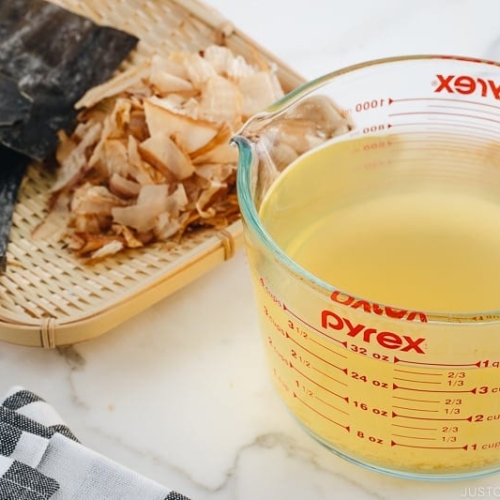
Awase Dashi (Japanese Soup Stock)
Video
Ingredients
- 1 piece kombu (dried kelp) (10 g; 4 x 4 inches, 10 x 10 cm per piece)
- 1 cup katsuobushi (dried bonito flakes) (packed; 10 g)
- 4 cups water
Instructions
Before You Start…
- Sometimes life happens and you just don‘t have 20 minutes to make dashi from scratch. On those occasions, you can use a Dashi Packet or Dashi Powder.

- Gather all the ingredients. Most Japanese recipes would say to gently clean the kombu with a damp cloth. However, these days, kombu is quite clean, so just make sure it doesn't have any mold spots and it‘s ready to use. Do not wash or wipe off the white powdery substance, as it has lots of umami.

- Make several slits in 1 piece kombu (dried kelp) to release more flavor.

To Make the Cold Brew Kombu Dashi Ahead of Time (Optional)
- Put 4 cups water and the kombu in a large bottle and let it steep on the counter for 2–3 hours in the summertime and 4–5 hours in the wintertime. You can also cold brew the kombu dashi overnight in the refrigerator.

To Make the Awase Dashi
- Add the kombu and water to a medium saucepan. If you have cold brew Kombu Dashi (previous step), add the Kombu Dashi and hydrated kombu to the saucepan.

- Turn on the heat to medium low and slowly bring to almost boiling, about 10 minutes.

- Meanwhile, clean the dashi by skimming the foam and debris from the surface.

- Just before the dashi starts boiling gently, remove the kombu from the saucepan (discard or repurpose in other recipes—suggestions follow). If you leave the kombu in the saucepan, the dashi will become slimy and bitter.

- Add 1 cup katsuobushi (dried bonito flakes) and bring it back to a boil again.

- Once the dashi is boiling, reduce the heat, simmer for just 30 seconds, and turn off the heat.

- Let the katsuobushi sink to the bottom, about 10 minutes.

- Strain the dashi through a fine-mesh sieve over a bowl or measuring cup. Reserve the katsuobushi and repurpose it; see the suggested recipes that follow. The Awase Dashi is ready to use.

To Store
- If you are not using the dashi right away, store the dashi in a bottle or mason jar and keep it in the refrigerator for 3–5 days or in the freezer for 2 weeks.

What to do with the spent katsuobushi and kombu?
- Save the spent kombu and katsuobushi in an airtight container and store it in the refrigerator for a week or in the freezer for up to a month.

- With the spent kombu, you can make Simmered Kombu (Kombu Tsukudani).

- You can also make Homemade Furikake (Rice Seasoning).

Optional: Niban (Second) Dashi
- In a medium saucepan, put 2–4 cups* of water and previously used kombu and katsuobushi from making the first dashi. Bring it to a boil over medium-low heat. *2 cups would make a stronger dashi.
- Remove the kombu just before the liquid comes to a boil, then lower the heat, and cook for 10 minutes, skimming occasionally.
- Add an additional ½ cup (5 grams) of fresh katsuobushi and turn off the heat.
- Let the katsuobushi sink to the bottom and strain the dashi through the fine-mesh sieve.
Nutrition
Editor’s Note: This post was originally published in January 2013. The images and content have been updated in April 2019.
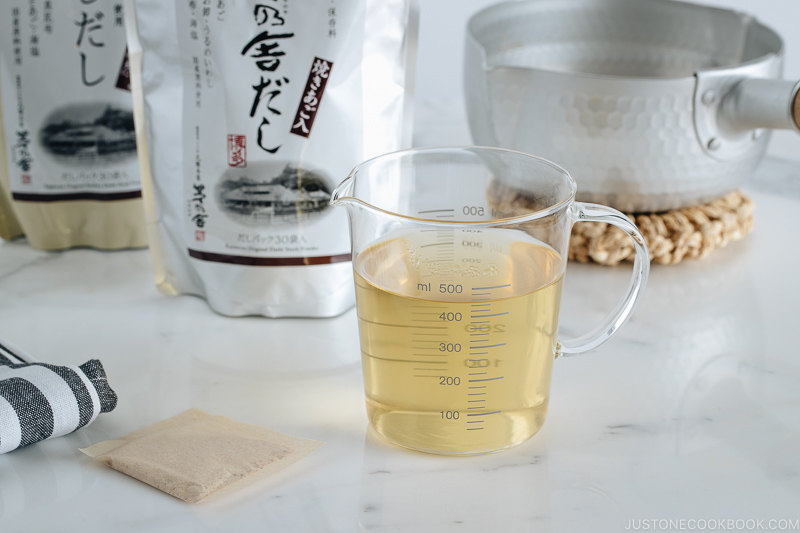
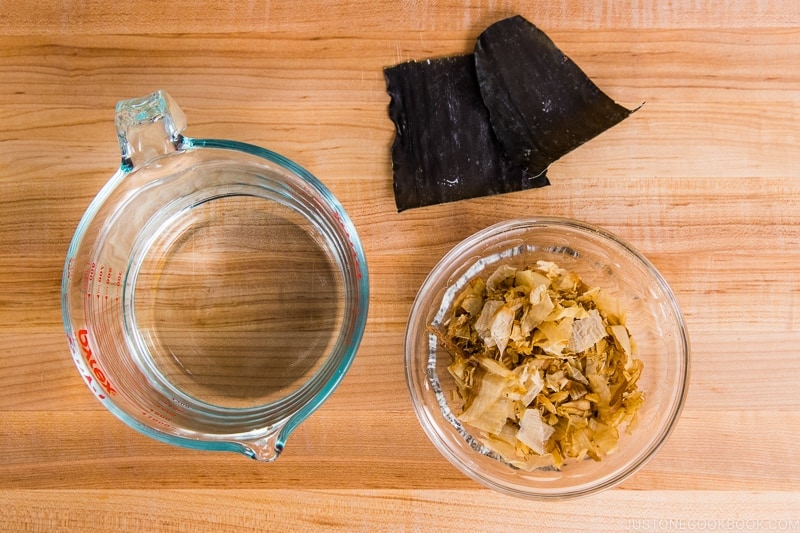
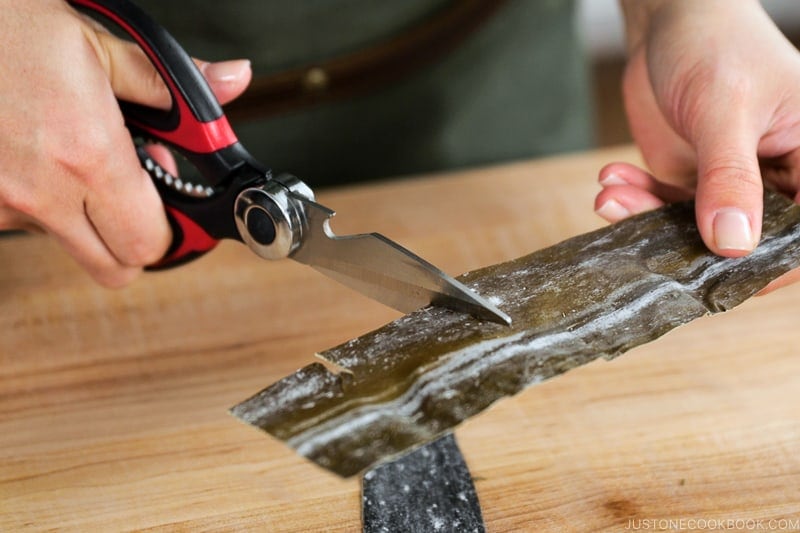
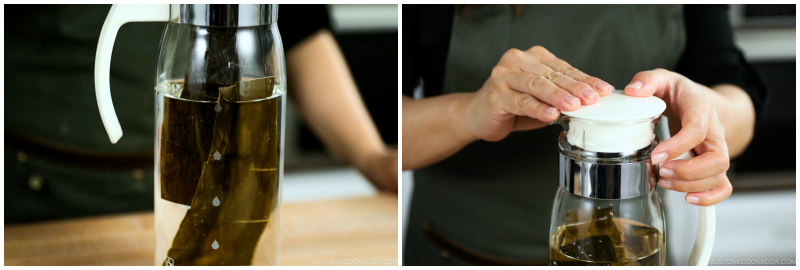
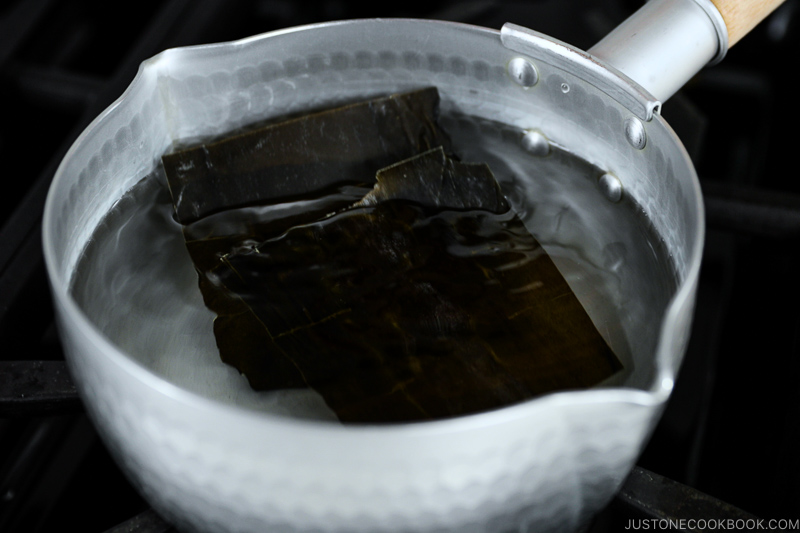
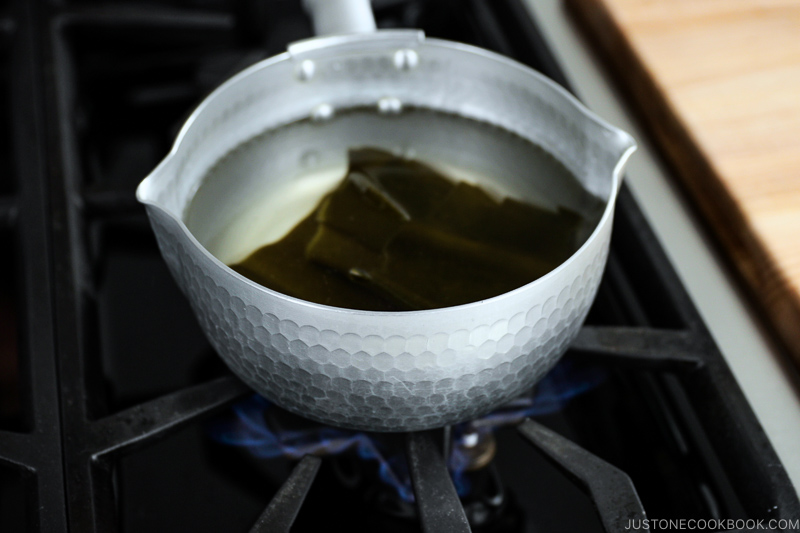
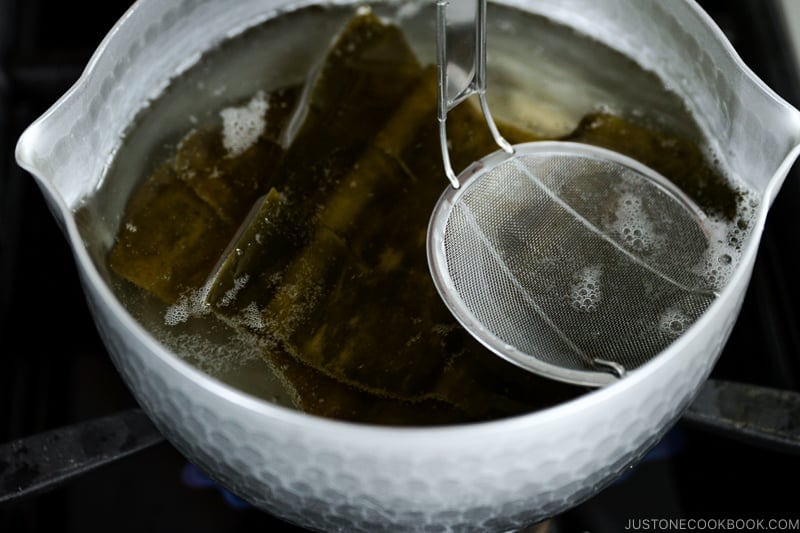
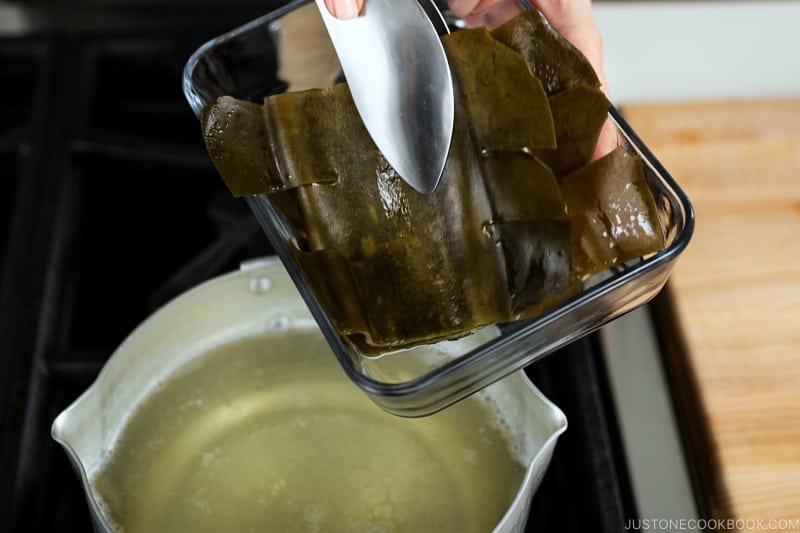
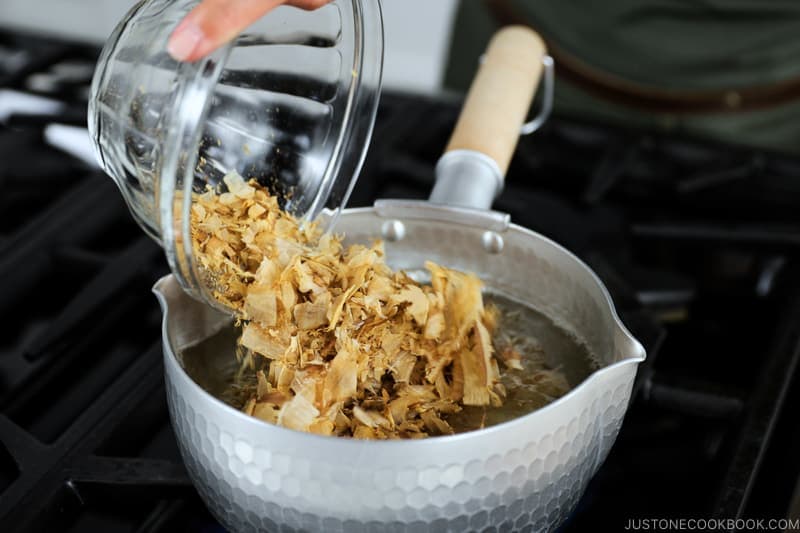
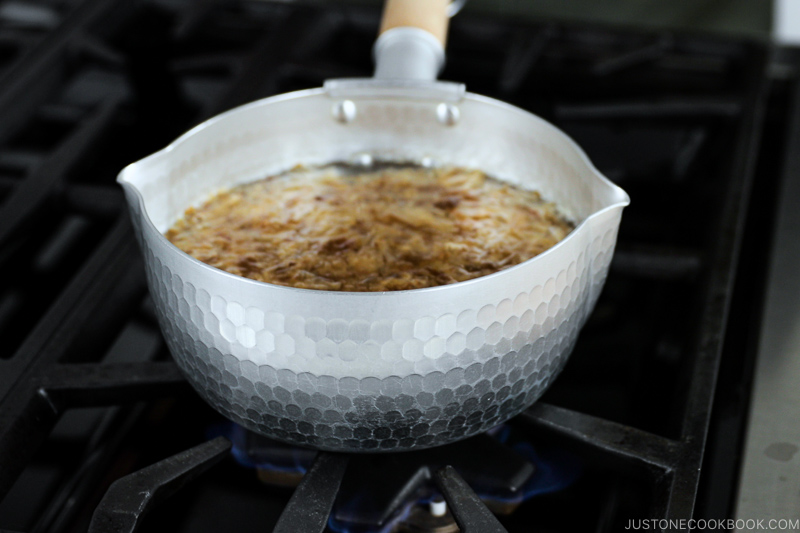
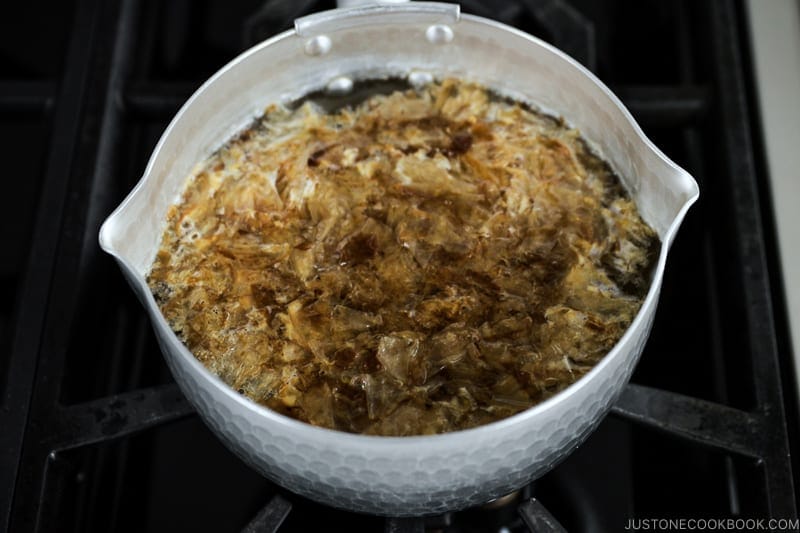
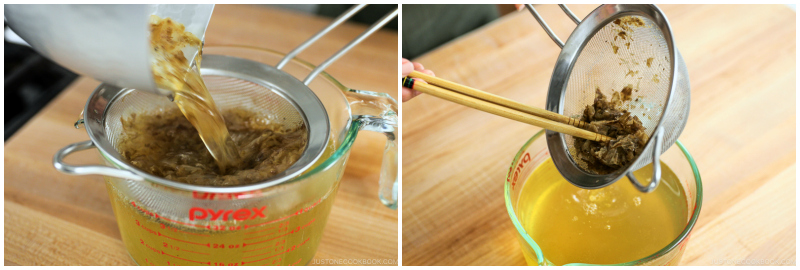
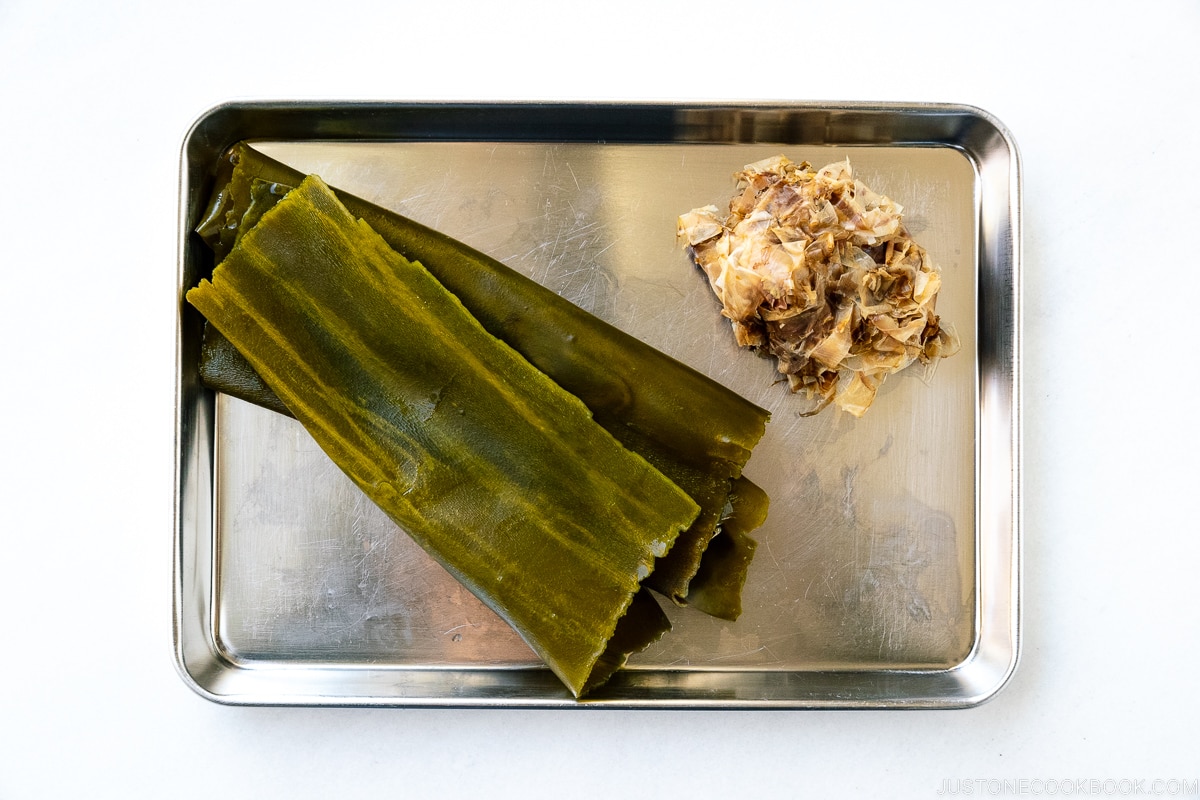
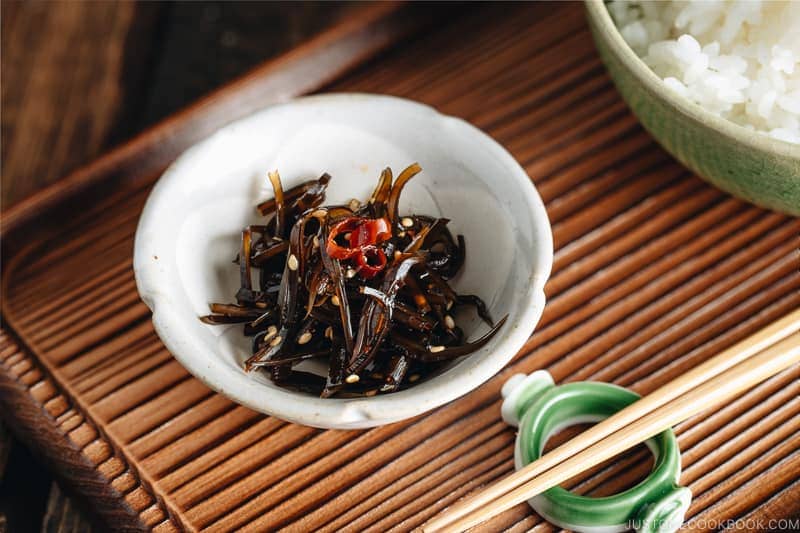
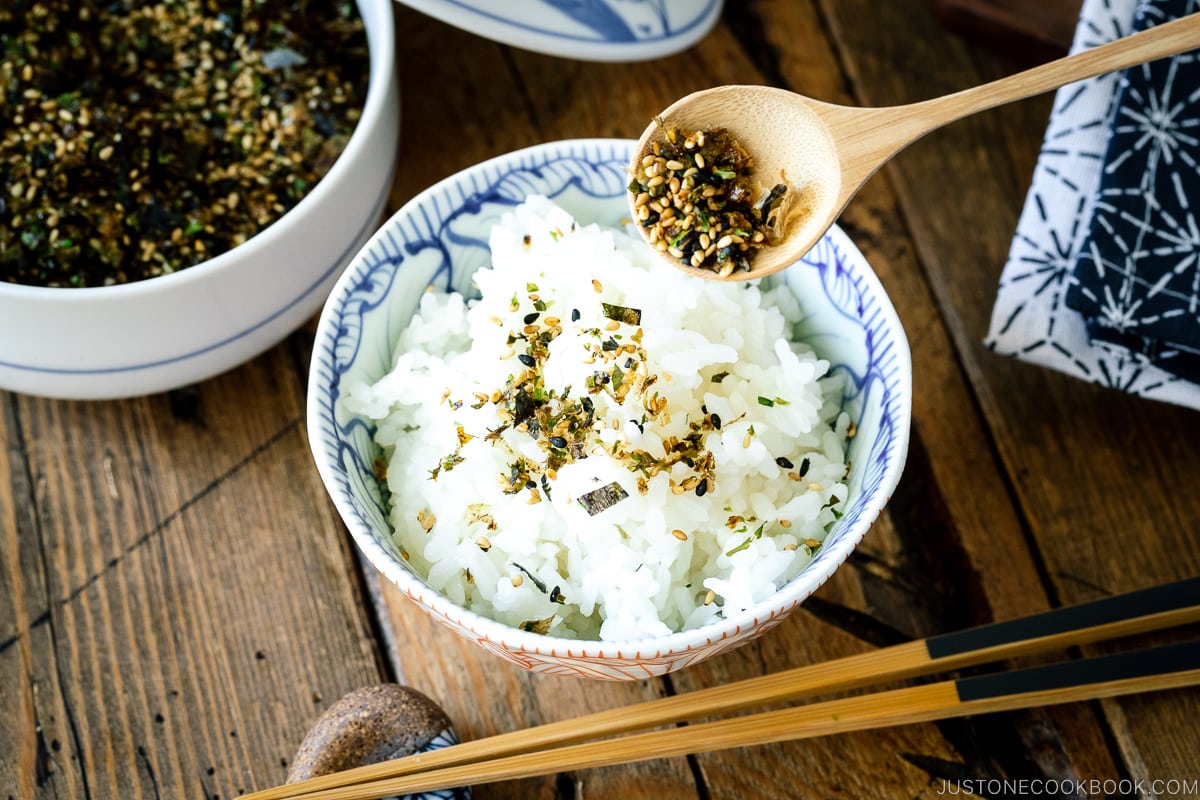










This recipe was perfect! I followed the recipe as closely as I could, and ended up using the majority of the dashi stock for miso soup later that day, and I must say…. the miso soup was some of the best I’ve ever had! It brought me right back to sipping it at the best restaurants in Japan, and far exceeds all the Canadian Japanese spots I’ve ever frequented. And the great thing is, it was actually quite easy to make (albeit a bit time-consuming, but not too bad if you prepare in advance). I will most definitely be using this recipe from now on instead of the instant dashi granules, as there is simply no comparison between the two; I don’t think I could ever go back! Thank you so much Nami for helping us create this incredibly authentic and flavorful dashi stock. I feel like a Japanese housewife being able to make this!
Hi Shannon! I’m so happy and excited to hear that you tried this recipe and enjoyed the homemade dashi! I haven’t used dashi granule for years (except for that I have to use for dashi granule tutorial for the blog). It’s much easier than making chicken stock from scratch right? 😉 Hope you enjoy using homemade dashi in many of Japanese cooking!
Hi Nami,
Thanks for all the great recipes. I’m planning to make matsutake gohan tomorrow. My dear wife kindly offered to shop for ingredients and has come back from the store with two 500ml paper cartons of dashi liquid. I can make out that the characters really do say dashi (one is 白だし, one is だし醬油) but I have no clue if this is concentrated or how much I should dilute it or even which to use. Obviously don’t want to ruin my matsutake by pickling them in salty broth. Please if you have time I would appreciate your help.
Thank you!
Hi Paul! I think I know which brand. I took the pictures of them, but I didn’t upload them to my Pantry page. I was going to write how you will use it…. then forgot about it.
Shiro Dashi 白だしalready includes kombu / katsuobushi dashi, white soy sauce (made from flour, not from soybean), usukuchi soy sauce (=light color soy sauce), mirin, and sugar. So you will not need other seasonings. This is ready to use seasoning.
I’m not sure how many rice cooker cups you’ll use, but let’s say, if you cook 3 cups, you’ll probably need 1/4 cup to 1/3 cup (4 tbsp to 6 tbsp) shiro dashi and 1 Tbsp. sake, then add the water till 3 cup rice line.
Hope this helps!
Hi Nami,
I want to try this but just realized that I bought Dashi base (the darker brown liquid kind) instead of the dried packets you mix with water. Do you know if the kind that I bought is the “wrong kind of dashi” for this soup/flavor? I feel like it’s much to strong though to be used with your quantities.
Here it is: http://sunrisemart-ny.com/default_eng/yamaki-kappo-shiro-dashi-katsuo-400ml.html
Thanks!
Hi Ali! The dashi you bought is fine! You can use it, but you have to dilute it. 🙂 I actually bought one today to see how it tastes like. I haven’t tested but you will need to dilute at least 2-3 parts for 1 part water, I think.
Hi Nami,
Can you give me an idea how much dashi one would use for a miso soup? In other words, does one use STRAIGHT dashi or dashi plus some water. Thank you
No water is necessary. Miso soup is basically dashi + miso + whatever ingredients you want to add. So if you know the size of bowl you’re going to serve, basically you need the dashi for that bowl x # of servings. Hope this helps!
What is your opinion of the bottled Shiro Dashi?
Hi Elaine! I’ve used it before, and it’s convenient if you need 1 Tbsp. dashi in the recipe and you have no plan to make miso soup. Most of the time, I use dashi for whatever I need to make dishes, and the rest goes to miso soup. So I don’t need the shiro dashi bottle. 🙂
Hi Nami!
About to make my second batch of your delicious dashi. 🙂
Quick question, what dishes will niban dashi be good for? Thank you!
Hi Rebecca! I am so sorry I missed your comment somehow in my inbox. Nibandashi is not as good as first one, so if you plan to add more flavor in addition to dashi, it’s a good use. Like simmered dishes (nimono), or even miso soup. Just a little lower grade dashi. 🙂 Again, I am so sorry I missed your comment!
I was wondering if you can use dried shrimp instead of bonito flakes? I want to make a shrimp pasta (not quite scampy) dish, but pump the unami flavor up with a dried shrimp dashi.. I figure it would be cool since there is a anchovy dashi? Would you use the same proportion of bonito flakes -swapped for dried shrimp, or is it customary to use both and split the difference?
Hi Justin! Even Japanese style pasta (we call it Wafu Pasta) that includes shrimp, we tend to use regular dashi to make the pasta. We rarely use dried shrimp for dashi except for certain dishes (mostly Chinese style recipes). We consider shrimp flavor is too strong for the Japanese style dish. You can definitely make stock using dried shrimp, but it might be up to your liking how much dried shrimp you want to use… Start with small amount and see? 🙂
Nami,
Thank you for this recipe!
It might seem a bit strange…but I’m actually making dashi for my cat. I feed him commercial frozen raw food (from Nature’s Variety; ground rabbit or duck or chicken, complete with organs and bones plus a small bit of other stuff), and I serve it (thawed, of course) with twice as much liquid as food to make sure he stays very well hydrated. I had been using warm tap water plus a small spoonful of Trader Joe’s “Tuna for Cats” canned food…but then I discovered that he goes absolutely nuts for katsuobushi and so I’m using your dashi instead — which he also loves. He licks the bowl clean and dry!
I have a question, though…for niban dashi, should the kombu be removed once it reaches a boil just as for ichiban dashi, or do you leave the kombu in for the whole ten minutes of simmering?
Thanks,
b&
Hi Ben! Definitely one of interesting comments I have received! 🙂 Your cat is very lucky and it seems like he eats very well! Just like Ichiban Dashi, I recommend taking kombu out before boiling. Kombu makes the broth bitter and slimy and it’s not neccesary. However, you can leave it out in water for a longer time, or cook the water with kombu slowly to get maximum flavor. There are lots of stories in Japan that cats go crazy with katsuobushi. It made me smile to hear your story.
Thanks for the clarification! I just made another batch this afternoon, and he licked his lunch bowl clean again so I still must be doing something right. And the last batch made some really, really good miso soup for me….
I can easily believe the stories of Japanese cats that go crazy for katsuobushi. Baihu’s reaction to it is almost embarrassing in how desperately excited he gets in just the time it takes to get it out of the bag to when he can reach it in my hands. I imagine there must be quite a few very lucky cats in Japan, what with all the katsuobushi, dashi, and fresh seafood there. I’m sure not all cats eat as well as their humans…but those who do must think they’re in heaven.
b&
Hi Ben! Does your cat like the leftover katsuobushi from making dashi? Or all the flavor is out and he doesn’t like it? I didn’t think too much about it, but yeah cats in Japan must be so happy eating all kinds of seafood meals. 🙂
Alas, he doesn’t. Nor does he like katsuobushi sprinkled on top of a bowl of food and liquid…I suspect the texture is a big part of the draw and the mushiness of soggy katsuobushi doesn’t seem to appeal to him.
But the flavor of the dashi definitely does…if I give him just plain water with his food, he only eats the food and leaves whatever water he isn’t forced to get by eating the food. And he might get fussy and wait a while before deigning to eat. But with dashi? No more than a minute or three after I set the bowl down and it’s licked clean!
…time to make another batch….
b&
Thank you for your answer, Ben! I guess the texture of the food is very important even for a cat. 🙂 I’m so happy to hear your cat enjoy dashi! It’s really a cute story. 😀 Thank you!!
can we use the konbu leftover for ramen topping?
Hi Def! Without cooking in seasonings, kombu can be very plain and not much taste to it. How do you want to serve the leftover kombu in ramen?
I have a question. I’ve been wanting to make dashi from scratch for a long time. I just got back from the Asian market and I just noticed that the bonito flakes that I bought say “smoked and dried”. Is that the same thing or did I buy the wrong package? Sorry, I know it’s a stupid question but I’m very new to Asian cooking, i don’t really know what I’m doing yet.
Hi Tiffany! You got the right one. 🙂 It should look like this.
https://www.justonecookbook.com/pantry/dried-bonito-flakes-katsuobushi/
Can I make dashing with dried shrimps?
We do make dashi with dried shrimp but we use it for certain dishes that goes well with strong shrimp flavor. Not meant for all dishes that require dashi. 🙂
Forgive me if you’ve already answered this! I skimmed the comments but did not see where anyone has inquired of you the name of a legitimate online supplier of the ingredients Kombu and Bonito Flakes. I live 57 country miles outside the great & sophisticated city of Cleveland, where there exists “real” Japanese grocers which I’d love to visit. I can go to Cleveland. In about four weeks! I need Miso soup now!!! Please help me, Nami! If anyone reading this knows of such a site, please let me know. Respectfully….
Hi Carolyn! You can buy Kokubu and bonito flakes on Amazon.com or you can try Japanese online grocers such as Mitsuwa or Marukai:
http://store.mitsuwa.com/mobile/doi-dried-hidaka-kombu-kelp-p1469.aspx
http://store.mitsuwa.com/mobile/dried-bonito-flakes-80g-p1849.aspx
http://store.mitsuwa.com/mobile/dried-bonito-flakes-80g-p1849.aspx (Kokubu and bonito dashi powder)
And another store Marukai: http://www.marukaiestore.com/
Hope this help! Check on Amazon price as well. I did a quick check on Asian (Japanese, Korean, Chinese) markets in Cleveland but it doesn’t seem to carry many things (no Japanese…). Try online shopping. Feel free to ask me if you need any help. Good luck!
Hi! Can I use iriko dashi in making takoyaki?
Hi Mikko! Yes you can! I hope you enjoy making takoyaki. 🙂
Ok so um i dont have the kombu sheets but the soup stock is that a good substitute or no?
Hi Jenna! If you don’t have kombu, you can still make Katsuobushi (bonito flakes) based dashi. There is no substitute for kombu, so you will be just making “Katsuo Dashi” with just bonito flakes. Follow the same directions (minus kombu part). 🙂
Great job! Is there any way to create an instant dashi powder from these raw ingredients? Like maybe grind the 2 ingredients and then add them to water later? Any ideas? Thanks
Hi Matt! Thank you so much. Hmmm even though you grind the raw ingredients, I think the powders/granules won’t be completely dissolved. So you will have to strain it. In that case, it makes more sense to make a tea bag dashi packet. That way after you boiled the dashi packet, you can pick it up and throw away. In Japanese supermarkets, there are meshed tea bag (disposable). A lot of people make their own dashi packet using those tea bag. Hope this helps. 🙂